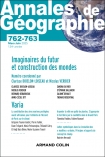
ANNALES DE GÉOGRAPHIE N° 762-763 (2-3/2025)
Pour acheter ce numéro, contactez-nous
Recevez les numéros de l'année en cours et accédez à l'intégralité des articles en ligne.
La découverte de détroits, de passages ou l’ouverture de canaux sont des évènements localisés aux conséquences globales, d’abord quant à la réorganisation du trafic maritime. Les discours produits lors de ces évènements sont riches d’enseignements sur les horizons d’attentes des sociétés contemporaines. Nous avons analysé un corpus de textes produits lors de l’ouverture du canal de Suez (1869) et la réactualisation du projet déjà ancien de la route du Nord-Est (années 2010). Au-delà de l’expression commune d’une utopie largement techniciste de réduction des distances et de conquête de l’espace mondial, les discours produits lors de ces évènements rendent compte de deux imaginaires du futur très différents qui se traduisent par des inscriptions dans le temps et dans l’espace qui diffèrent également de manière significative. Alors que l’ouverture du canal de Suez semble annoncer l’arrivée d’un monde meilleur, ses promoteurs inscrivent ses effets à l’échelle du globe et dans le temps long d’un futur indéterminé, celle de la route du Nord-Est, conséquence directe du réchauffement climatique est l’expression pragmatique et cynique d’un modèle de société exploitant ses propres externalités négatives, sans se projeter plus loin de la moitié du XXIe siècle.
The discovery of straits or the opening of passages are localized events with global consequences, notably in terms of the reorganization of maritime traffic. In the discourses on these events, they often take on even greater importance : they enable encounters with the Other, the opening and closing of the world, the coming of a new world, etc. The discursive productions that proliferate during these events are therefore rich in information about the expectations of contemporary societies. Our hypothesis is that, depending on the period in which these events take place, we observe not only an evolving image of the world, but also a change in perceptions of time. We therefore propose to compare the discourses produced at the time of the opening of the Suez Canal (1869) and Ann. Géo., those produced with a view to the opening of the Northeast Passage at the turn of the 2000s, based on a corpus of texts contemporary with these events. There are a number of points in common. Firstly, the expression of utopias related to the spatio-temporal reduction of the global scale : improved journey times are the cornerstones of these discourses. Secondly, the expression of strong expectations in terms of the benefits linked to the trade of goods that will transit through these passages. Thirdly, they inspire discourses linked to their political impact on the appropriation of parts of the world : Suez represents an undeniable asset in the colonial conquest and management of European colonies, while the Northeast Passage exacerbates the expression of rivalries in the appropriation of Arctic space, particularly with regard to natural resources. However, these two projects belong to two eras with radically different visions of the future ; therefore, two registers of uncertainty reveal a divergence in how the future is envisioned. Thus, in the 19th century, the speeches surrounding the digging of the Suez Canal demonstrated faith in progress, whether technological or scientific, in the beneficial aspects of linking the world’s societies and in the benefits of trade for populations as a whole. When uncertainties were expressed, they were technical in nature and concerned doubts about the canal’s efficiency, often expressed in terms of profitability. Almost 150 years later, when the Northeast Passage is opening, there is no trace of progress in the discourses. On the contrary, the texts point to a cynical headlong rush to pursue a model of society whose limits we now know, and to the desire to take advantage of global warming, which is encouraging maritime traffic in polar zones, while uncertainties are becoming existential. We consider that these two registers illustrate a process of erosion of utopian visions of the future world, which is further illustrated by the presence of two radically different time horizons : indefinite for discourses linked to the Suez Canal, rarely exceeding 2050 for the Northeast Passage.

